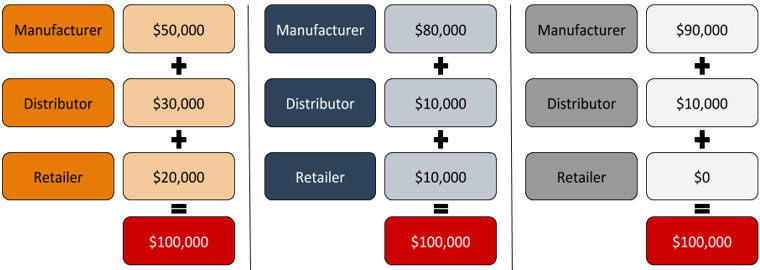Products break. But when they cause an injury, you could have a defective product liability claim.
We use commercially made products every day. Maybe even every minute of every day. Accidents happen, and sometimes they're just that… accidents. Unavoidable, and no one's fault.
For example, if you accidentally hit a wine glass on the cabinet door as you take it out, it could break and you could be cut. Is it defective? No. Glass breaks, and even though you were using it the way it was intended, unless it was manufactured and marketed as special unbreakable glass, there's probably not a claim to be made.
On the other hand, consider this scenario:
You're asleep in your bed. When you roll over in the middle of the night, the movement causes one of the legs to break free from your bed, which causes the bed to become unbalanced. You fall off and suffer a head injury when your head hits the floor.
It turns out that the bed frame is designed to have an extra part that absorbs shock and keeps the legs steady even when there's movement, but your bed frame was missing that part. Unlike the broken glass that was likely no one's fault or negligence, the bed frame scenario could have a very different outcome.
Let's take a look at when an injury could lead to a product liability claim in California.
Types of California product liability claims
California law says that strict liability applies when someone designs, manufactures, or sells a defective product even if there was no negligence.
In most personal injury lawsuits, the plaintiff must prove that the defendant's action or inaction was negligent, reckless, or with intent to cause harm. However, when a product is defective, that standard doesn't apply.
There are 3 types of defects that can lead to a product liability claim:
- Design defect. This happens if a product is inherently dangerous because the design wasn't safe. Even if it's manufactured exactly according to the design specifications, it remains a dangerous product when used correctly. The only way to correct the defect is to change the design and create the product differently.
- Manufacturing defect. If a product is damaged, not assembled properly, or otherwise comes through the manufacturing process incorrectly, it could result in a manufacturing defect.
- Inadequate warnings. Even if the product is designed and manufactured exactly as expected, sometimes injuries happen because the labels or packaging didn't provide sufficient warning to the consumer about possible dangers or incorrect use.
Here's how to distinguish between these 3 types of defects:
| Category | Example | Conclusion |
|---|---|---|
| Design defect | Terry buys a toaster oven. He uses it according to the instructions. When he reaches to take out his toast, he burns his hand because the handle to open the door is very hot. | This is a design defect because the company should've used a material that wouldn't conduct heat for the handle. |
| Manufacturing defect | Sally buys a hedge trimmer. After reading the instructions, she starts using it on her unruly hedges. However, after a few minutes the safety cover flies off and she gets hit. | This is a manufacturing defect. If the hedge trimmer had been built according to the design, it wouldn't have injured her. The screw was not attached during manufacturing. |
| Failure to warn | Molly buys a new pair of shoes for her newly walking toddler. She looks closely at the shoes and sees that there's a clear layer of thin plastic on the outer soles, but she assumes it's part of the shoe and leaves it there. That was packaging material designed to be removed. But her child wears the shoes and the slippery plastic causes her to slip and fall. | The plastic on the shoe should've been labeled that it was to be removed before wearing. Molly made a reasonable mistake in thinking it was part of the shoe. |
Who's at fault in a product liability claim?
The defendant in a product liability claim could be any party in the product's chain of distribution.
In other words, every product has a “life” or a journey before it gets to the consumer (end user). Any person or company who had a role in bringing that product to the consumer could be liable for a defect.
This includes:
- Manufacturers. The manufacturer seems like the obvious defendant in a product liability claim, but it's not always so straightforward. A lot of products, especially appliances, contain components that are made by a variety of suppliers. If the defect is the result of a malfunction of one particular part of the item, the defendant could be the manufacturer of the part and not of the entire product. Normally, the manufacturer of the entire product (whoever's name is on the box, usually) is also a defendant, but they could be joined by a secondary defendant.
- Wholesalers or distributors. Often, a manufacturer will send a product to a wholesaler or distributor for packaging, shipping, and other logistics. These logistics companies can also be liable for mistakes that happen when they're in control of a product.
- Retailers. You can make a claim against any party in the chain of distribution, which could include the store where you bought the item. California law doesn't provide for an “innocent seller” exception, like some states do.
Joint and several liability
Joint and several liability is a legal doctrine that essentially says that each defendant would be liable together (jointly) and separately (severally) for the entire damage award.
For example, if the court awards $100,000 in damages and the defendants are Manufacturer, Distributor, and Retailer, each party is responsible for all of the $100,000 and they need to determine amongst themselves how it's divided.
For example, it could be any one of these scenarios (or any other combination):

What if Distributor can't afford to pay its share?
If that happens, the other 2 defendants are responsible for that amount so the plaintiff would receive their $100,000, regardless of who pays.
Who can make a defective product claim?
Anyone.
That's right. Anyone who was injured by a defective product has the right to file a claim. It doesn't matter if you purchased the item or it was given to you. You don't even have to be the person using the product — if you were injured because someone else was using a defective product, you're still eligible to file a claim.
If you were injured by a product you acquired used or secondhand, you might be able to make a defect claim, depending on the product, the type of defect, and how you acquired the item.
Elements of a California product liability claim
There are certain elements that must be proven in any personal injury lawsuit. Since a California product liability lawsuit doesn't hinge on negligence, the elements are slightly different from a regular personal injury claim.
There are 4 elements to a California products liability claim:
- The defendant designed, manufactured, distributed, or sold the product.
- The product was defective when it left the defendant's control.
- The plaintiff used the product in a reasonably foreseeable manner.
- The plaintiff suffered injury as a direct result of the defect.
What is “reasonably foreseeable” use?
“Reasonable” use of a product doesn't mean you have to use it specifically according to the instructions. In fact, California law requires a manufacturer to anticipate how a consumer might use a product — even if the consumer's doing it wrong.
But the manufacturer can't anticipate (or foresee) every misuse.
Let's face it, a coat rack isn't meant to be used as a chin-up bar. Tires for a bicycle aren't meant to be repurposed for a baby stroller. Once the user takes the product to a level that the manufacturer couldn't have anticipated or expected, they void their right to a product liability claim.
Let's look back to the example of the broken bed frame that we discussed earlier. Say the leg broke because the buyer's 3-year-old was jumping on the bed. Is a bed meant to double as a trampoline? No.
But it's foreseeable that children jump on beds. It should've been able to withstand the weight of an average-sized child.
Still, it's always best to read instructions, warning labels, and other package inserts before using a product. Especially for appliances, there are warnings that should be paid attention to for your own safety.
Common defenses to product liability claims
If you file a lawsuit for a product liability injury, there are a few common defenses that the defendant might use to try to disprove your claim:
- Your defendants are incorrect. In other words, the named defendants aren't the companies that designed, manufactured, distributed, or sold the item.
- The injury was caused by your own negligence or you used the product in a way that wasn't reasonably foreseeable.
- The product in question wasn't the cause of your injury.
- The product wasn't defective when it left the defendant's control.
- Some other party interfered with the product and caused its defect.
- An alteration or repair was made negligently.
- You haven't proven your injury or associated damages.
What to do after a defective product injury
If you were injured by a defective product, first and foremost you should see a doctor to treat your injuries.
Also, preserve the evidence. Keep the product exactly in the condition it was in when you were injured. Don't continue to use it, and don't alter it in any way or try to “fix” it.
Take photos of any damage, if you're able to do so. Obviously, you can't photograph what's already happened, but you might be able to show the aftermath. Especially if the item has broken, a photo of a crack or missing piece could be valuable evidence.
It's also important to have it documented in your medical record how the injury happened. Ask the doctor to include details like, “The patient's right index finger was severed because the door stopper broke and the door slammed shut on her finger.” They don't need to mention all of the details (and doctors are busy, so they often only take the notes they feel are necessary), but there should be some comment about how the accident occurred.
The fact that a product is defective isn't enough to file a claim. You'll also need to prove that you were injured as a result of the defect, and that injury was enough to warrant damages.
Defective product damages
The intent of personal injury law is that the damages you can recover are for the purpose of restoring you to the condition you were in prior to the injury. If your injury required a trip to a hospital or doctor, or any other medical treatment, the costs associated with your medical services are economic damages.
If you lost time at work, or it will cost you money in other ways like requiring additional services or aid because your injury prevented you from carrying out your normal activities, then those costs can be compensated, too. If the injury was severe, you might be able to recover non-economic damages for pain and suffering or punitive damages.
However, if your injury was minor and you didn't need medical treatment, you're unlikely to recover damages in a product liability claim.
There must be a cost involved, whether economic or emotional.
Finding a California product liability lawyer
If you've been injured by a defective product and you're wondering what your options are for recovery, a California product liability lawyer should be your first contact. Find a lawyer with the experience, skill, and training to handle complex legal matters and who will work for you to recover the damages you deserve.
Did you know that product liability law varies by state?
Need a lawyer?
What does an injury lawyer do?
A personal injury lawyer helps individuals who have sustained injuries in accidents to recover financial compensation. These funds are often needed to pay for medical treatment, make up for lost wages and provide compensation for injuries suffered. Sometimes a case that seems simple at first may become more complicated. In these cases, consider hiring an experienced personal injury lawyer. Read more














